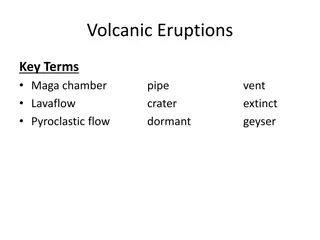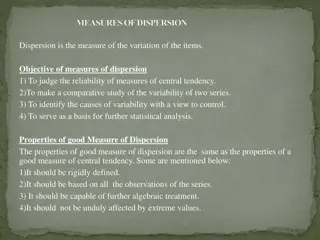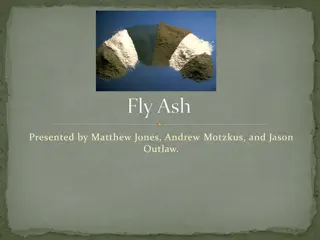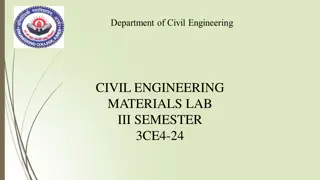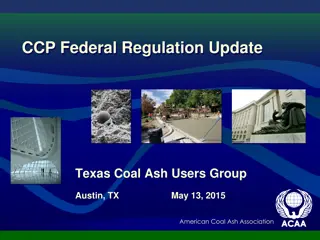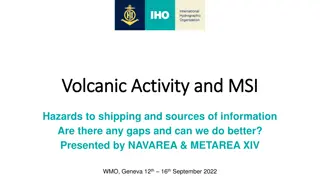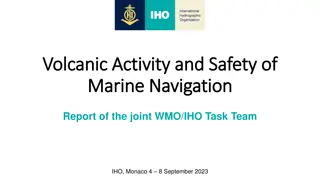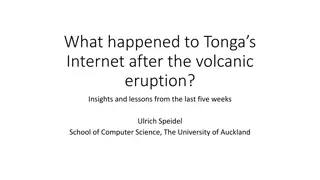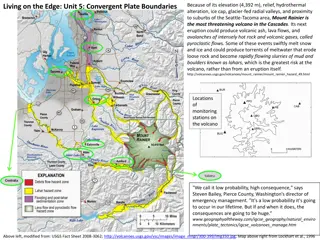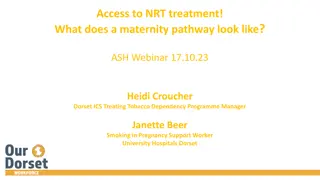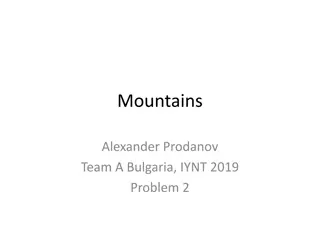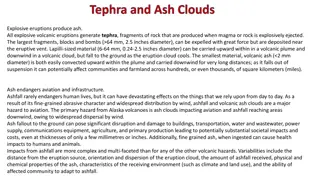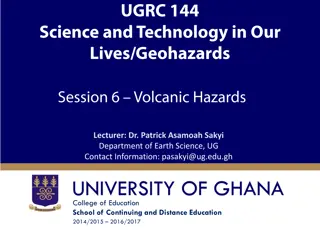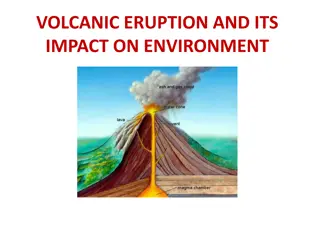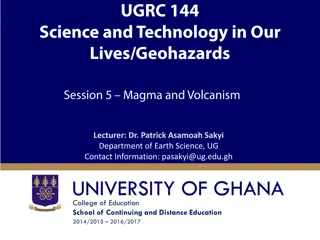Understanding NOAA's HYSPLIT Model for Predicting Volcanic Ash Dispersion
NOAA's HYSPLIT model is crucial for predicting the transport and dispersion of volcanic ash. By utilizing satellite data, this model aids in issuing advisories for aviation safety. Applications of the model extend to various atmospheric tracer studies. Inverse modeling techniques are employed to estimate emission rates effectively.
Download Presentation

Please find below an Image/Link to download the presentation.
The content on the website is provided AS IS for your information and personal use only. It may not be sold, licensed, or shared on other websites without obtaining consent from the author. Download presentation by click this link. If you encounter any issues during the download, it is possible that the publisher has removed the file from their server.
E N D
Presentation Transcript
Tianfeng Tianfeng Chai Roland Draxler Roland Draxler1 1, Michael J. Pavolonis , Michael J. Pavolonis3 3, Ariel Stein Chai1,2 1,2, Alice Crawford , Alice Crawford1,2 1,2, Barbara Stunder , Barbara Stunder1 1, , , Ariel Stein1 1 NOAA Air Resources Laboratory, College Park, MD NOAA Air Resources Laboratory, College Park, MD Cooperative Institute for Climate and Satellites, University of Maryland, Cooperative Institute for Climate and Satellites, University of Maryland, College Park, Maryland College Park, Maryland NOAA Center for Satellite Applications and Research, Madison, WI NOAA Center for Satellite Applications and Research, Madison, WI 1. 1. 2. 2. 3. 3.
Motivation Currently NOAA National Weather Service (NWS) runs the Hybrid Single Particle Lagrangian Integrated Trajectory (HYSPLIT) dispersion model with unit mass release rate to predict the transport and dispersion of volcanic ash. The model predictions provide information for the Volcanic Ash Advisory Centers (VAAC) to issue advisories to meteorological watch offices, area control centers, and flight information centers. Quantitative forecasts can be generated by estimating the volcanic ash source terms based on the satellite retrievals of volcanic ash mass loadings. 10/4/2024 Air Resources Laboratory 2
CAPTEX HYSPLIT Dispersion model NOAA ARL HYSPLIT (Hybrid Single Particle Lagrangian Integrated Trajectory Model) is used for volcanic ash dispersion forecasts Applications include the simulation of atmospheric tracer release experiments, radionuclides, smoke originated from wild fires, volcanic ash, mercury, and wind-blown dust, etc. The 8 Jun 2011 eruption of the Cord n Caulle volcano in South America for 0600 UTC (Stein et al, 2015, BAMS) Emergency Response Chemical Releases 10/4/2024 Air Resources Laboratory 3
Volcanic Ash- 2008 Kasatochi eruption MODIS volcanic ash mass loadings (left) and ash plume top height (right) of the 2008 Kasatochi eruption (shown with + ). Top: 13:00-14:00 UTC on Aug 8, 2008; bottom: 00:00-01:00 UTC on Aug 9, 2008 10/4/2024 Air Resources Laboratory 4
HYSPLIT Inverse Modeling Methodology In this top-down approach, the unknown emission terms are obtained by searching the emissions that would provide the best model predictions closely matching the observations. The unknowns of the inverse problem are the emission rates qiktat each location i, at different height k and period t. They are solved by minimizing a cost function F, 10/4/2024 Air Resources Laboratory 5
Past HYSPLIT inverse modeling application Fukushima Nuclear Accident Reference: Source term estimation using air concentration measurements and Lagrangian dispersion model Experiments with pseudo and real cesium-137 observations from the Fukushima nuclear accident, Chai, T., R. R. Draxler, and A. Stein, Atmospheric Environment, 106, pp. 241-251, doi:10.1016/j.atmosenv.2015.01.070, 2015 10/4/2024 Air Resources Laboratory 6
Volcanic ash mass loading calculations 1) Surface to cloud top; 2) Single layer; 3) Three layers. G1 G2 10/4/2024 Air Resources Laboratory 7
Sensitivity tests Volcanic ash release results with different background error estimations First guess (Background) uncertainty set as 1012 g/hr, or 2,800 kg/s First guess (Background) uncertainty set as 1016 g/hr, or 28,000,000 kg/s 10/4/2024 Air Resources Laboratory 8
Zero observations as extra constraints H: Clear regions, ash-free pixels; T: Clear column above ash cloud; B: Clear column below ash cloud. 10/4/2024 Air Resources Laboratory 9
Evaluation metric FB: Fractional Bias; KSP: Kolmogorov-Smirnov parameter Illustration of KSP (wikipedia.org) 10/4/2024 Air Resources Laboratory 10
Inverse modeling test results Rank (G2) MA: integrating from surface to cloud top; M0: a single model layer where the cloud top resides; M1: integrating over three layers centered at cloud top. 10/4/2024 Air Resources Laboratory 11
Inverse modeling test results Rank (G4) 0Z on Aug.10, 2008 MA: integrating from surface to cloud top; M0: a single model layer where the cloud top resides; M1: integrating over three layers centered at cloud top. 10/4/2024 Air Resources Laboratory 12
Summary Volcanic ash source terms are estimated by assimilating satellite observations; Forecasts with estimated ash source terms are good with Rank reaching 3.0; Different options in calculating the ash mass loadings do not make much differences; Extra zero observations do not help inverse modeling. 10/4/2024 Air Resources Laboratory 13
Thank you! 10/4/2024 Air Resources Laboratory 14
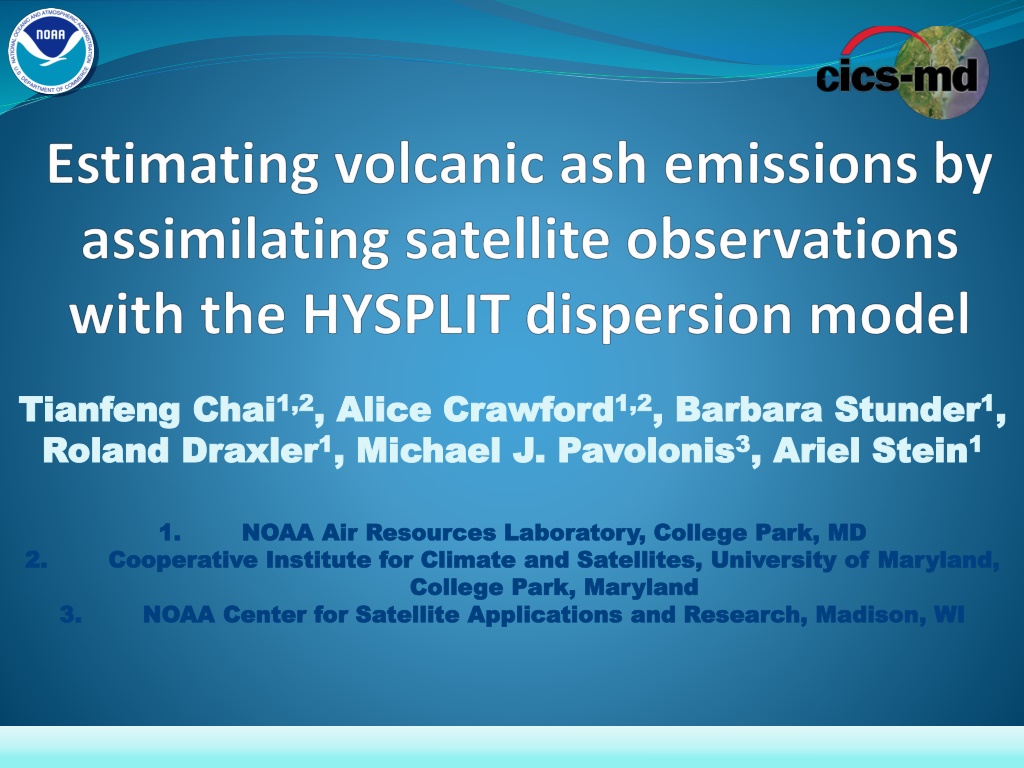


![Read⚡ebook✔[PDF] Io After Galileo: A New View of Jupiter's Volcanic Moon (Sprin](/thumb/21612/read-ebook-pdf-io-after-galileo-a-new-view-of-jupiter-s-volcanic-moon-sprin.jpg)



